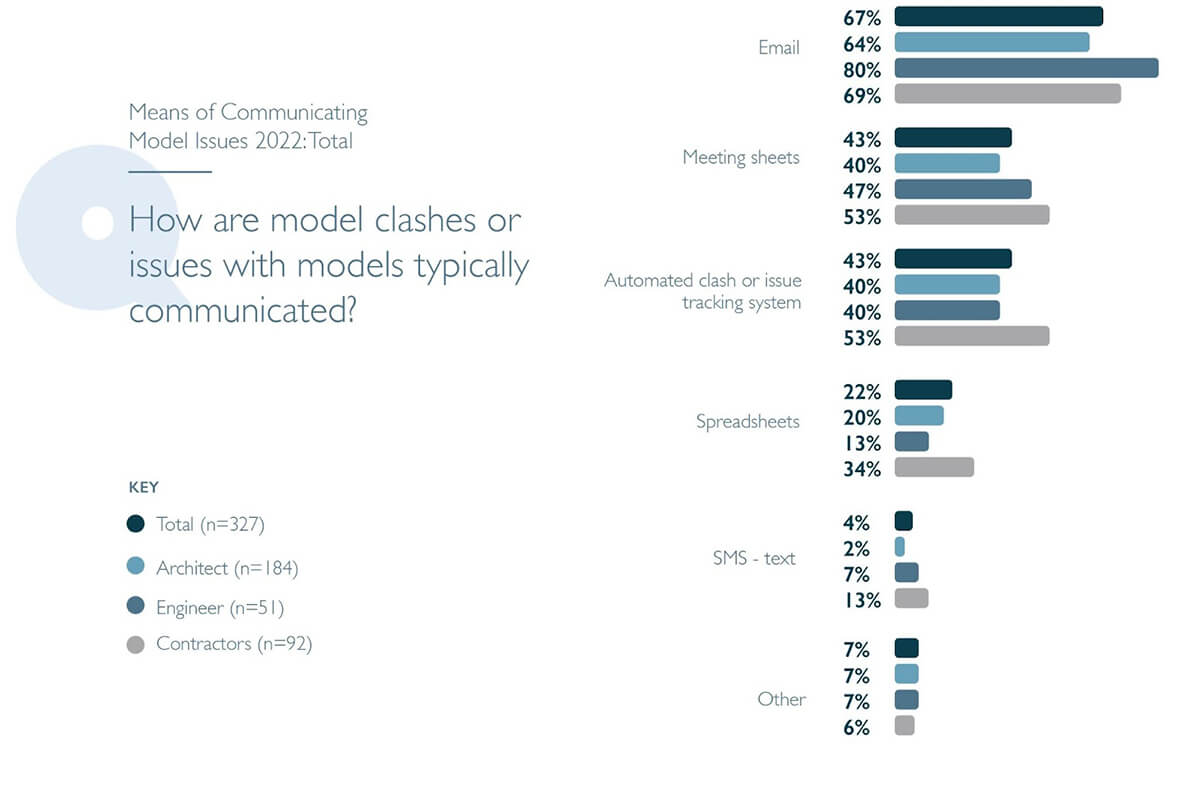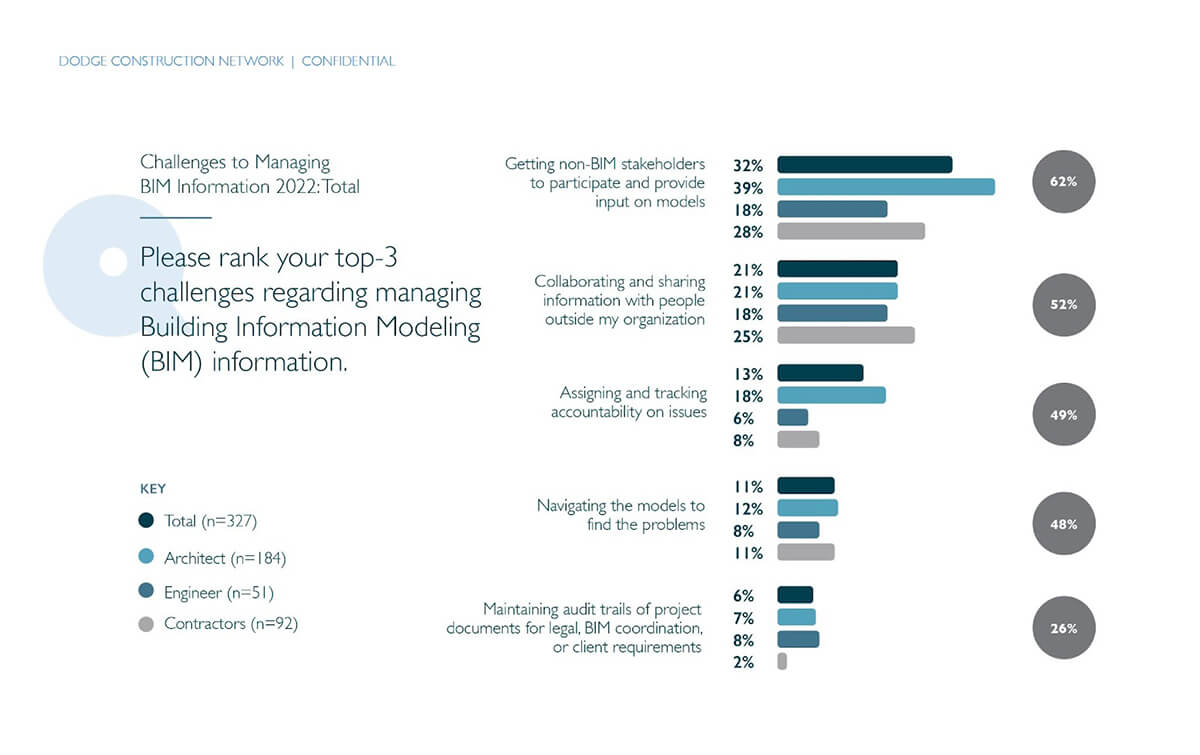Vous devez activer les cookies pour accéder à ce site.
This is part of our Essential Strategies for Harnessing Building Information Modeling (BIM) Coordination, this section emphasizes optimizing collaboration through effective BIM use. Uncover strategies to enhance workflows and reduce errors, leading to a more streamlined construction process.
Building Information Modeling (BIM) clash detection and issue management coordination are essential often considered parts of the design phase of a project, but this also extends to the operations and maintenance phases. Coordination, communication, and collaboration on model issues are key throughout the entire project lifecycle.
In our study, “Finding Common Ground: The Future of Project Information Management”, we asked specific questions regarding challenges with Building Information Modeling (BIM) coordination, including how model clashes and issues are communicated.
The responses were surprising.
Challenges With External Communication
We asked a more general question regarding challenges with communication, specifically with external parties. More than half of architect, engineering, and contractor respondents indicated that they receive incomplete information. However, many contractors also indicated that they also do not receive information in a timely manner. And almost half of the contractors say that the information they receive is unclear.
During the construction phase, communication and collaboration on model issues are critical. Mistakes are made if the information received is unclear or not delivered in a timely manner. These errors often result in rework, schedule delays, and increased costs.
Bottom line: it impacts all parties’ profitability.
Email Communication Of Issues May Be The Culprit.
We asked, “How are model clashes or issues with models typically communicated?”
Most of our respondents said that they communicated model issues via email. Surprisingly, almost 70% of contractors and 80% of engineers use email to communicate issues.
Herein lies the problem. Email communication is prone to delay, prolonging the issue tracking process. It relies on human interaction for a response. It also must be sent to the right person or group at the right time. Effective email communication also depends on individual communication styles. Responses communicated through email can be misunderstood or unclear to the recipient.

Advantages To Automated Clash and Issue Tracking Systems.
Communicating clash detections and running issue tracking tests are one thing, Detection of an issue or clash is one thing. But ensuring these issues are resolved in a timely manner is another. This is where real-time communication between all stakeholders is critical.
Several automated tools, such as Autodesk Navisworks™, are commonly used for clash detection. These tools allow BIM managers and coordinators to identify any interference between objects on a model. As opposed to manual clash detection (where a user navigates the model personally), this automated process saves a lot of time and avoids overlooked clashes, which are always much less expensive to manage during the design phase than during the construction phase.
But once a clash is detected, the actions taken to communicate and resolve an issue can make or break a project.
What Is The Difference Between Clash Detection vs. Clash Coordination?
Many automated clash detection tools are not designed to manage the coordination aspect.
Obstacles can also arise when there are different tools used across external project teams. All team members may not have license access to a particular system, which can hinder the coordination process.
For example, not every discipline on a project may have a license for Autodesk Navisworks. However, there are options to resolve technology disparities. Solutions provided by Newforma allow different collaborators to share information even if they don’t use the same software.
Newforma’s Building Information Modeling (BIM) functionality ties in with Autodesk Navisworks to coordinate the resolution of clashes (among other functions). It takes the results of any clash detection and converts them into coordination issues. Those issues are then available centrally to the whole team, which facilitates communication between stakeholders. Any stakeholder can reply, comment, or resolve the issues that have been assigned to them directly, and every participant in the project is made aware of the state of the project.
Start By Assigning Responsibility.
Determining who is responsible for addressing the issue is the starting point. This can be complex, given the interdependencies of systems in construction. It often requires collaboration across disciplines. An automated system for collaborating and communicating in real-time removes the email communication obstacles.
Assigning responsibility and having visibility into what actions are being taken holds people accountable. In our “Finding Common Ground” study, almost half of respondents cite assigning and tracking accountability on issues as a major Building Information Modeling challenge. A Building Information Modeling (BIM) coordination platform provides a level of transparency required to build accountability into the process.

Transparent Issue Tracking
Having an automated system is critical to the success of a project. It centralizes communication and makes information available to every participant.
During the project lifecycle, transparency allows the project participants to be aware of every issue affecting the project. Each project has so many interdependencies that a small change to one element of a model can have far-reaching consequences. Keeping every stakeholder in the loop early ensures that any changes in the system are understood.
Automated collaboration tools also include project notifications that keep teams on track by informing specific stakeholders about updates to issues, tasks, and clashes.
Some of the things to track include:
-
What is the nature of the issue?
-
Who was the issue assigned to?
-
When did the user create/update an issue?
-
When was the issue resolved and how?
Building Project Record For Risk Management
When a Building Information Modeling (BIM) manager is able to catch an issue early in the design phase, thanks to efficient coordination, it will reduce friction points as the project advances. This eliminates ambiguities and ensures accountability for all involved.
In addition, the history (including the issues and how they were ultimately resolved) can be used to fill in the data gaps for the next project.
Implementing An Automated BIM Coordination System.
Start With A Plan
Having a BIM coordination execution plan is an essential starting point. The plan provides stakeholders with a guide on how issues, clashes, and other essential topics will be reported on. It also establishes standards for how your data will be stored and accessed, and with what software. Your team then knows where to find the project details. Next, plan out what the communication and coordination workflow looks like. Having a centralized view of information, as provided by a Project Information Management (PIM) solution, simplifies these workflow processes.
Stakeholder Buy-In
All parties should agree on standard processes that are well-understood and followed. These include communication, documentation, and follow-throughs. If the stakeholders buy into the project, it has the best chance of success.
Demonstrate Construction ROI
What financial advantages of having an automated BIM coordination system? One way to demonstrate return on investment is to consider the time savings associated with model sharing.
Architecture and engineering models are very large files. In a decentralized system, each discipline would update their own files, make references to spreadsheets and word documents, and transfer them using large file-sharing tools (such as FTP). This could introduce hours or even days of delay; those work hours add up.
A coordination system records each change to the model and is accessible to anyone else on the project team. There is no need to upload and download different models and have a separate consolidation phase since the coordination happens in real-time. This saves money, improvesconstruction ROI, stakeholder satisfaction, and ultimately leads to more successful and lucrative projects.

